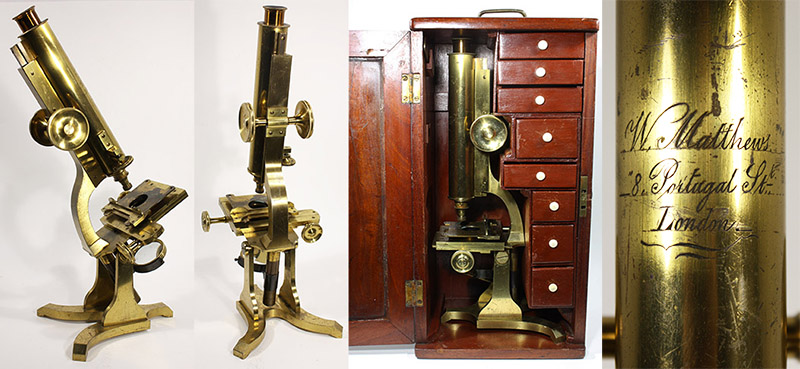
Figure 1. Compound microscope by William Matthews. All known microscopes of this style bear the address 8 Portugal Street (see also Figure 2). Dates from between ca. 1853, when Matthews moved to that site, and his death in 1868.
William Matthews, 1815-1868
(Portugal and Carey Streets)
Walter William Matthews, 1842-1906
Henry Matthews, 1849-1926
(Matthews Brothers)
by Brian Stevenson
last updated June, 2017
William Matthews was primarily a manufacturer and retailer of surgical and other medical apparatus, as was his father before him, and his sons afterward. During the mid-1850s, Matthews expanded his repertoire to include microscopes. The early models are unique in design, and were undoubtedly manufactured in Matthews’ workshop by himself and his skilled metalworker employees (Figures 1-7). Lenses were brought in from outside. Two of his sons, working as Matthews Brothers, continued to supply microscopes into the 1870s, although they were the era’s standard “Society of Arts”/bar limb style, and may have been made by outside wholesale manufacturers (Figures 8-9).
His shops on Portugal Street and the adjacent Carey Street were close by King’s College Hospital, and he was long the official supplier to the hospital (Figure 10). Lionel Beale (1828-1906), who wrote extensively on microscopy and medicine, was a neighbor, with a shop at 27 Carey Street. The proximity and good relationship between the two men is obvious in Beale’s writings, wherein he frequently refers readers to Matthews shop for cutting instruments, syringes, collecting bottles and other implements (e.g. Figures 11-12). It is likely that Beale inspired Matthews to begin making microscopes. They were relatively inexpensive but of good quality, designed for medical students and middle-class amateurs. Beale wrote in 1857 that Matthews was one of “the first makers in London who brought out a really good, cheap, practical instrument, furnished with foreign object-glasses”. Jabez Hogg, in 1861, wrote, “The microscopes made by Messrs. Smith and Beck, Mr. Matthews, Mr. Pillischer, Mr. Ladd, Mr. Dancer, M. Nachet, &c., will be found to meet all the requirements of the amateur or student”.
Another person of the same name also made and sold microscopes at around the same time. That William Matthews operated from Camden Road, and made a unique style of case-mounted microscope. There are no records of the Portugal Street / Carey Street microscopist ever having a location on Camden Road, nor are any of those case-mounted instruments inscribed with either Portugal or Carey Street. The second Mr. Matthews, and his possible identification, are described in a separate essay.

Figure 1.
Compound microscope by William Matthews. All known microscopes of this style bear the address 8 Portugal Street (see also Figure 2). Dates from between ca. 1853, when Matthews moved to that site, and his death in 1868.
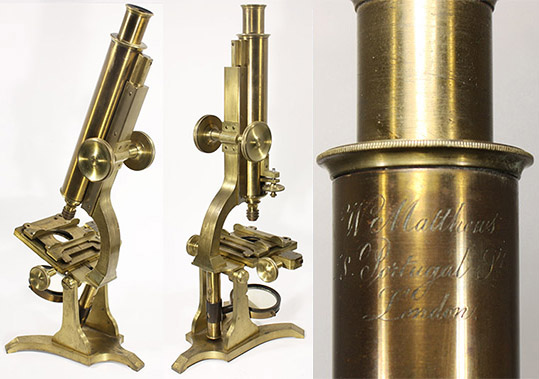
Figure 2.
The same model as illustrated in Figure 1, but with the foot arranged in the opposite direction.
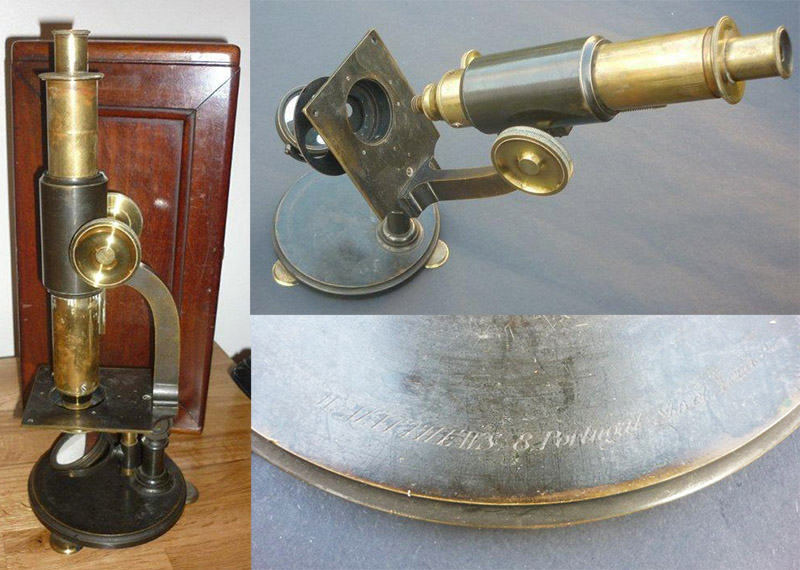
Figure 3.
A different early model of microscope by Matthews, 8 Portugal Street. Adapted for nonprofit educational purposes from an internet auction site.

Figure 4.
The earliest known advertisements for microscope supplies and instruments by William Matthews. From ‘The Lancet’, 1855 (left) and 1856 (right).
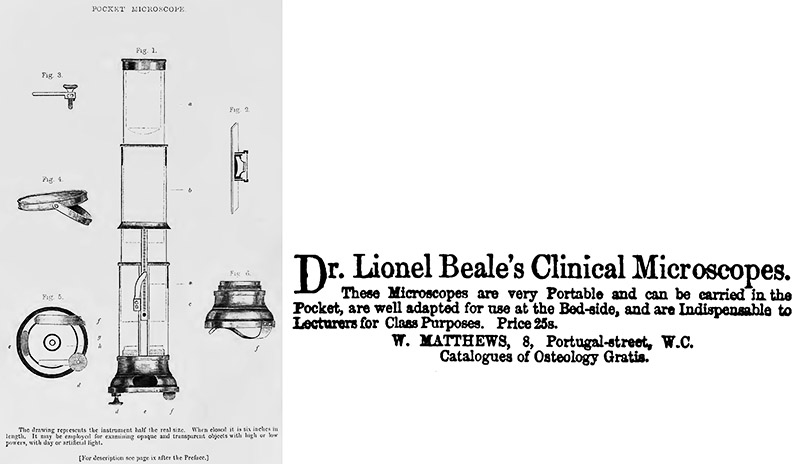
Figure 5.
Diagram of Beale’s demonstration microscope, from his 1861 second edition of ‘How to Work With the Microscope’ (the first edition to have illustrations). An advertisement by the manufacturer, William Matthews, from ‘The Medical Times and Gazette’, 1861.
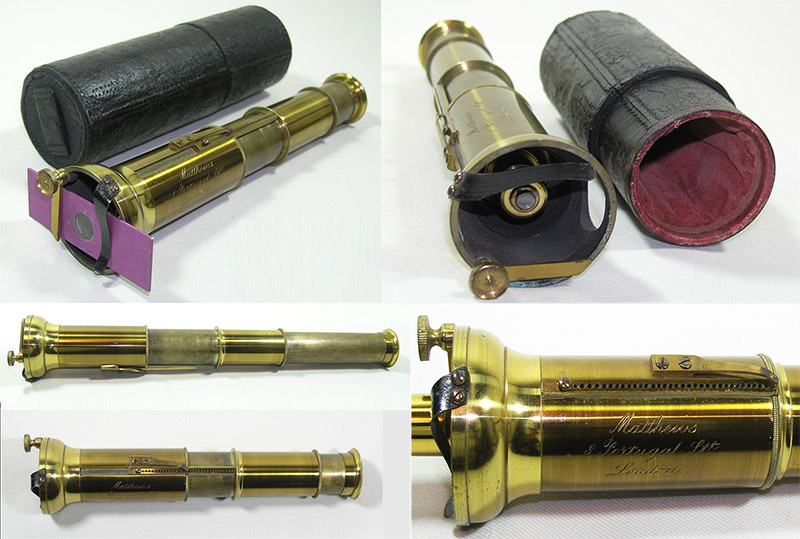
Figure 6.
A surviving Beale’s demonstration microscope, by William Matthews, 8 Portugal Street. Although the slide-holding clips are of different designs, they are original to the instrument (see Figure 5). The microscope was intended for classroom and other demonstrations; the instructor could center a slide, set the focus, and pass the microscope among students without much risk of the slide being moved or the focus disturbed. Illumination is achieved by pointing the microscope toward a light source. The Matthews Brothers continued to offer this instrument in their 1874 catalogue.
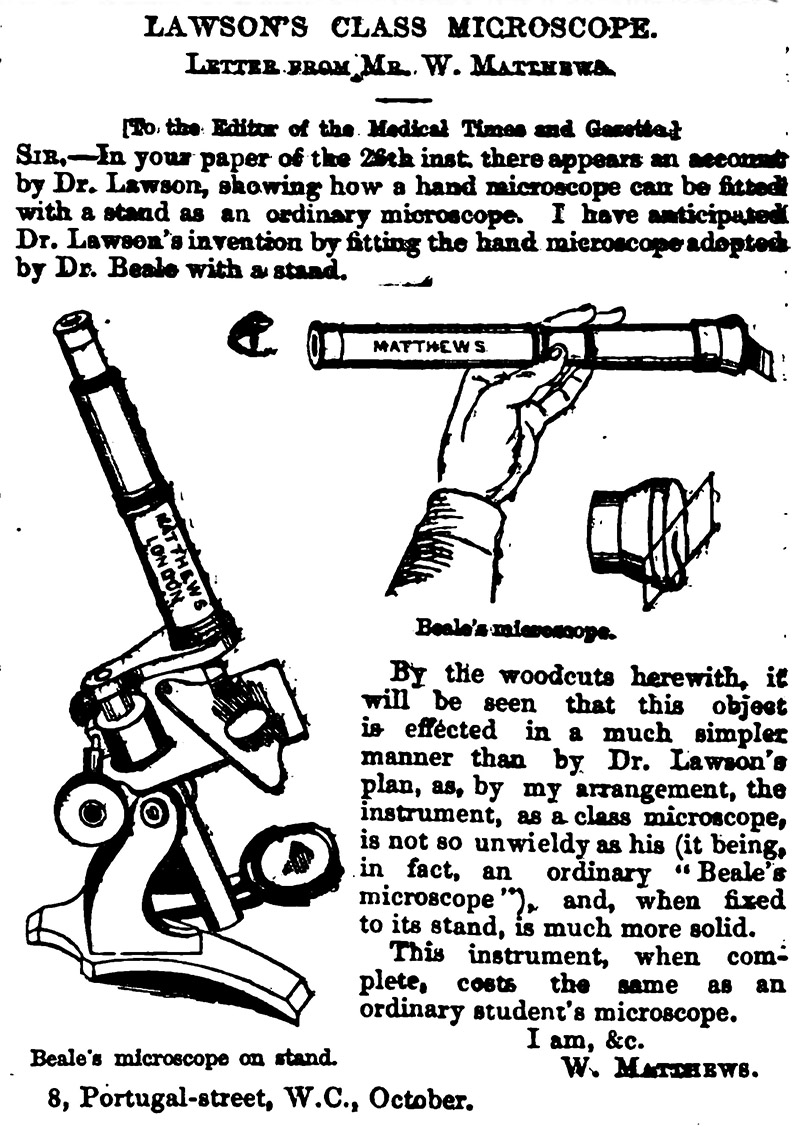
Figure 7.
An 1867 letter to the Editor of ‘The Medical Times and Gazette’, in which William Matthews describes his Beale’s microscope, and his adaptation of the instrument to mount on a stand. In a letter published earlier that year, Henry Lawson claimed to be the first to design a microscope that could be used in either a stand or be held in hand.
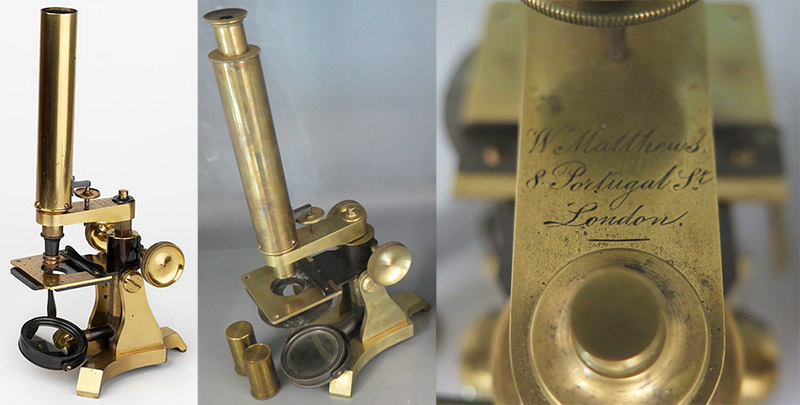
Figure 8.
Two bar-limb / “Society of Arts” style microscopes, by W. Matthews, 8 Portugal Street. They are similar to the instruments advertised by Matthews Brothers in 1874 (see below), and may represent Matthews’ later microscopes. The pattern is similar to that which was sold by countless shops of the time, and may well have been made by an outside, wholesale manufacturer.
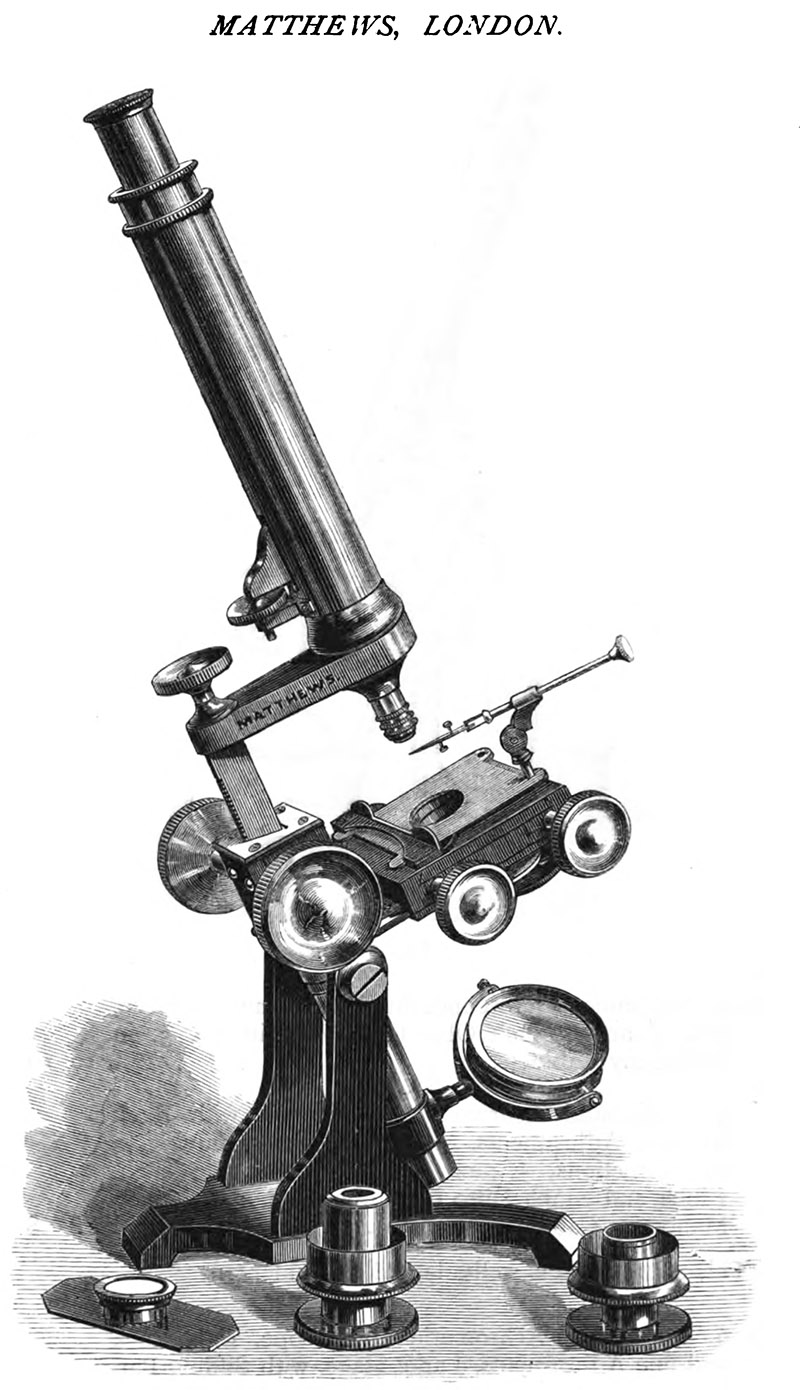
Figure 9.
Engraving from Matthews Brothers’ 1874 catalogue.

Figure 10.
A map showing the locations of the Matthews / Matthews Brothers shops, from the Matthew Brothers’ 1874 catalogue. The old shop (marked with an “O”) was on the corner of Portugal and Carey Streets, with doors that opened onto both roads (number 8 Portugal and number 32 Carey). In 1874, they moved to Lionel Beale’s former shop, at 27 Carey Street (marked with an “N”). They were conveniently located adjacent to the King’s College Hospital and the College of Surgeons.
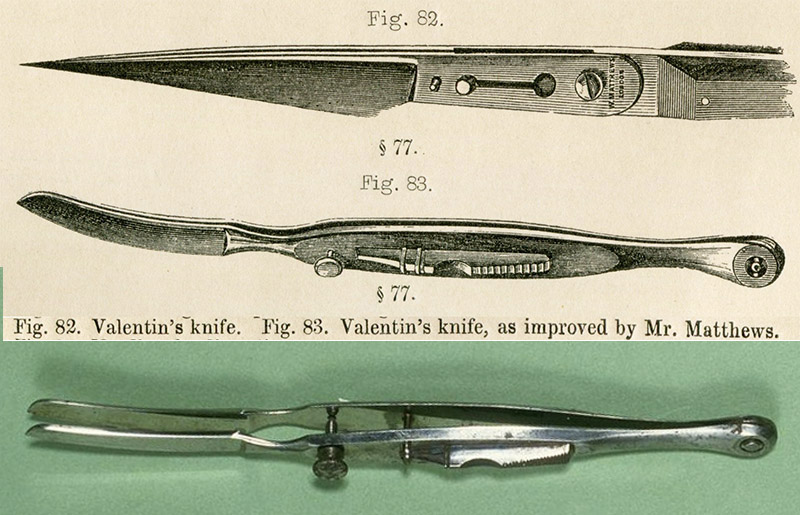
Figure 11.
Top: Illustrations of a standard Valentin’s knife, and an improved version by William Matthews, from Lionel Beale’s 1861 second edition of ‘The Microscope and How to Use It”. Bottom: A surviving example of Matthews’ Valentin’s knife. Adapted for nonprofit, educational purposes from an internet site.
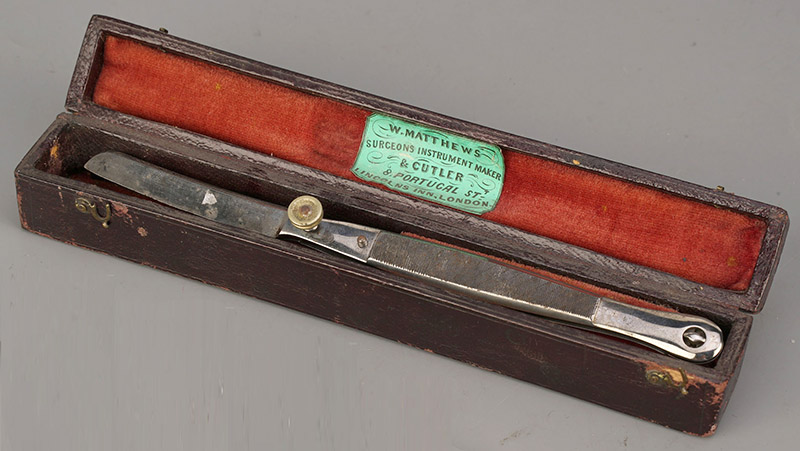
Figure 12.
A Matthews’ improved Valentin’s knife, with a somewhat different handle from those shown in Figure 11. Adapted for nonprofit, educational purposes from an internet auction site.
William Matthews’ father, Charles, was a skilled manufacturer of surgical instruments and other cutlery. At a time when guild membership was not necessarily correlated with profession, Charles Matthews was a member of the prestigious Goldsmiths’ Guild. By patrimony, William Matthews was also accepted into that guild, as were also his cutlery-making sons.
William was baptized on September 17, 1815, and so was probably born during the previous summer. He evidently began his training with someone other than his father, but for an unknown reason, he transferred the last year of his 7-year apprenticeship to Charles Matthews (Figure 13). A note on his transfer record indicates that this incurred a 20 shilling fine.
Having completed his training in 1837, William continued working for his father for another couple of years. The 1839 Pigot’s Directory of London listed only one cutler named Matthews, that being Charles, at 18 King’s Head Court, Shoe Lane. 1841 Post Office Directory of London listed Charles, and William at 11 Portugal Street, Lincoln Inn’s Fields. By July, 1842, Matthews had moved a short distance, to 10 Portugal Street. He remained at this site for another 11-12 years.
Matthews married in 1838, to Ann Hagtharp. Their first child, Charles, was born in 1839. He became a physician and surgeon. Second child Walter William (born in 1842) and fourth child Henry (born 1849) both trained with their father and eventually succeeded to his business. The third child, Emily, married a surgeon named John Harman. Their fifth and youngest child, Valentine, became a surgeon, like his eldest brother.
The Matthews family enjoyed a comfortable, middle-class life, recorded in both the 1851 and 1861 census as employing a live-in servant. The 1861 census reported that Matthews employed “4 men and 1 boy”.
William displayed a sampling of his wares at the 1851 London International Exposition. These were described as, “Inhalers, for medicines requiring the aid of heat. Inhaler, for administering chloroform in surgical operations. Inhaler, for hydrocyanic acid, conicine, &c. Improved stethoscope. Specula for the ear, &c. Gilbert’s patent fulcrum and chair, for extracting teeth. New swinging apparatus for fractured legs. Table knives”. He received a medal for this display.
In November, 1853, Matthews and one J. Rice received a patent for an “instrument for taking and applying vaccine matter”.
Matthews moved from 10 Portugal to 8 Portugal during circa 1853. A March 20, 1852 advertisement gave his address as 10 Portugal Street. The September 16, 1854 issue of Medical Times and Gazette included a list of surgical instrument-makers, with William Matthews at the corner location of 8 Portugal Street and 32 Carey Street.
He probably began making microscopes in about 1855. Advertisements from 1855 state that Matthews sold “surgical and microscopical instruments” (Figure 4). In 1856, he offered an “achromatic hospital microscope”. As noted above, Matthews produced “a really good, cheap, practical instrument, furnished with foreign object-glasses”.
Beale’s 1857, first edition of How to Work With the Microscope included numerous descriptions of Matthews’ instruments. Among these was an improved version of “Valentin’s knife”. Originally invented in 1838 by Gabriel Valentin (1810-1883), his knife consisted of two parallel blades whose spacing could be adjusted, to be used for slicing thin sections of human, animal, or other soft tissues. Beale wrote that, “The best form of Valentin's knife that I have used is that which I now show you. This has lately been made by Mr. Matthews. The blades of this knife can be completely separated from each other and easily cleaned. Moreover the distance between the blades is regulated by this little screw, which is a most convenient arrangement”. The Matthews version also had curved blades, which make it easier to slide into tissues (Figures 11-12). Beale also wrote that “Mr. Matthews has lately made some needles with cutting edges, which are very useful for making minute dissections”, “I shall have to allude to the method of using these preservative solutions when I describe the mode of examining textures under the microscope, and preserving them as permanent objects. Most of the preservative solutions which I have described may be obtained of Mr. Matthews, Portugal Street”, and “The different instruments required for making artificial injections are the following: An injecting syringe, of about the capacity of one ounce or even half an ounce. The piston of the injecting syringe should be covered with two pieces of leather, which may be very easily removed and replaced. The first is applied and screwed down with a brass button. The piston is then passed down the tube and forced out at the lower opening. The second piece of leather is then put on, and fixed in its place with another button. In this syringe, made for me by Mr. Matthews, the piston consists entirely of metal”.
Matthews won a medal at the 1862 London Exposition, for his “surgical instruments and appliances”.
William Matthews died on June 29, 1868. He, Ann, and their children had recently moved to Dulwich, Surrey. Sons Walter and Henry inherited their father’s business.
A 1876 description of the neighborhood recalled, “Carey Street is in a transient state; for on the west side only a few houses and inhabitants are left, viz., the Mission House; Messrs. Doyle and Edwards, solicitors; Messrs. Morrison & Son, old established and well-known painters and decorators, and the new establishment of Messrs. Matthews Brothers, surgical instrument makers which, some ten years ago, were the laboratory and residence of Dr. Lionel Beale, whose physiological work, performed here, has been rewarded by an European and historical renown; Messrs. Walter and Harry Matthews have gone to considerable expense in rebuilding the premises, fitting them in the most modern style and with the best taste; and, truly, although projectors of the contemplated improvements opened the ball by turning them out of their old place - which, now untenanted, has a most melancholy, not to say heartrending, appearance - they have acted wisely in building themselves anew in a style which will do credit to the new neighbourhood.”, and “At the corner of Portugal Street stands the establishment of Messrs. Matthews Brothers, the surgical instrument makers. This business was founded some thirty-five years ago by the late Mr. William Matthews, the father of the present proprietors (who died in 1868), and has been intimately associated with King's College Hospital from the commencement of that noble Charity. To the late Mr. Matthews and to the present firm certainly belongs the credit of inventing and perfecting many surgical instruments which are now historical, and from the frequent appearance of a well-known yellow carriage, with the dreadfully suggestive red hand painted on the escutcheon, at the door of No. 8, we infer that the visits of Sir William Fergusson do not resemble those of the proverbial angels, and that we may look forward to the advent of more instruments with a frightfully aggressive appearance, but which will no doubt do much to alleviate some of the sufferings of poor humanity”.
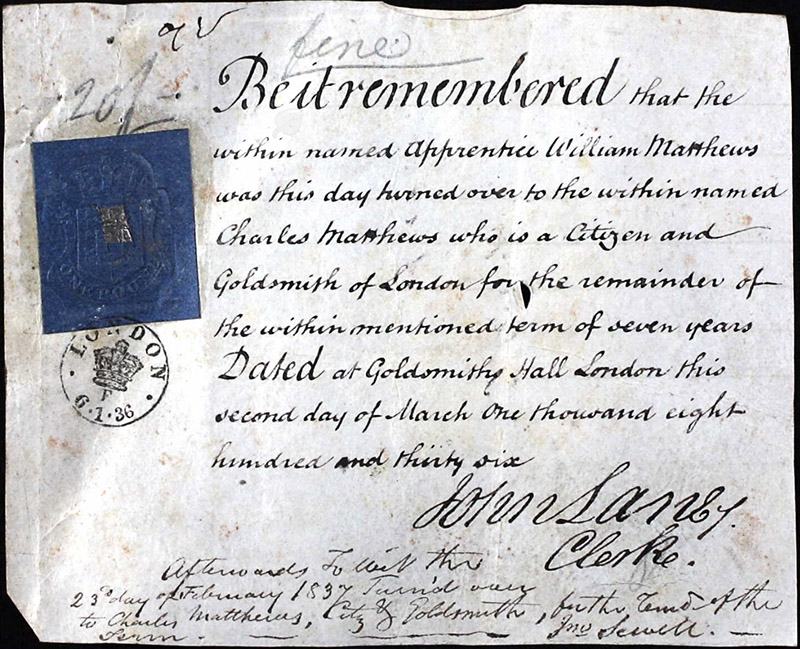
Figure 13.
1836 record of the transfer of William Matthews’ apprenticeship to his father, Charles.
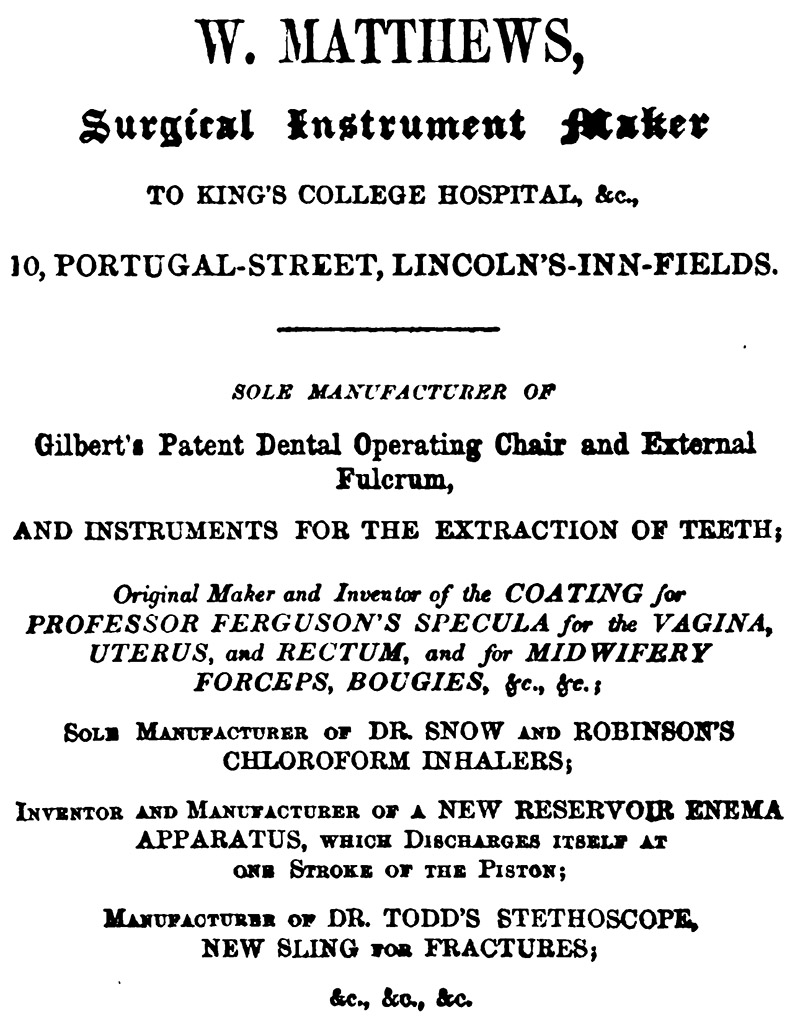
Figure 14.
An 1849 advertisement by William Matthews, from Henry Gilbert’s ‘On the Extraction of Teeth’.
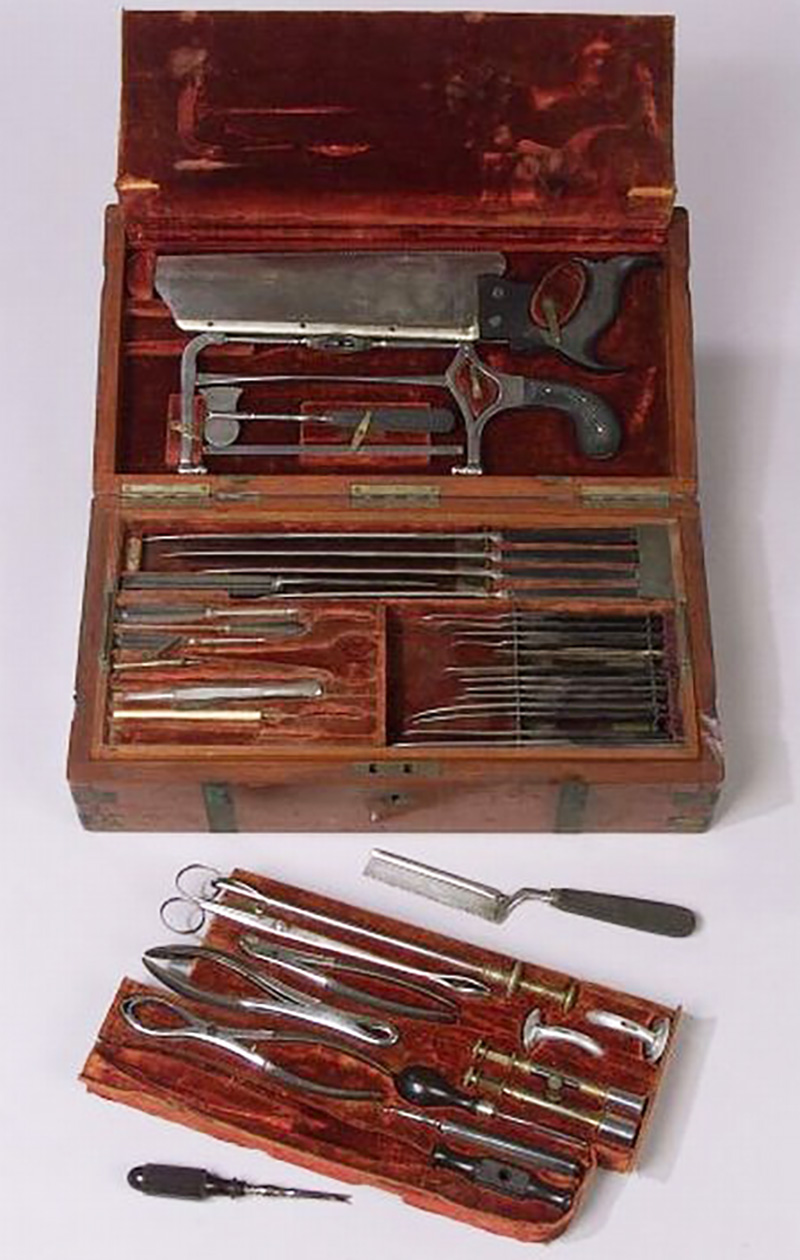
Figure 15.
A set of surgical instruments by William Matthews. Adapted for nonprofit, educational purposes from an internet auction site.
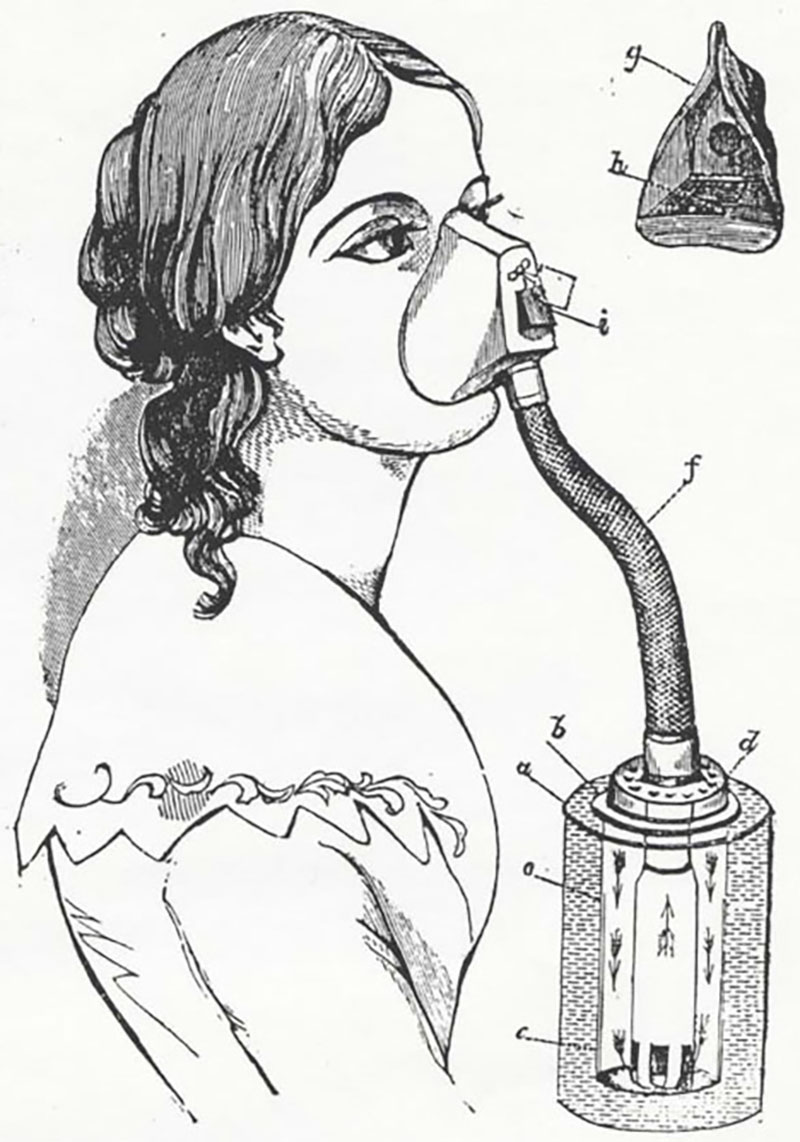
Figure 16.
Matthews’ chloroform-inhalation apparatus, described in 1848 by Dr. John Snow.
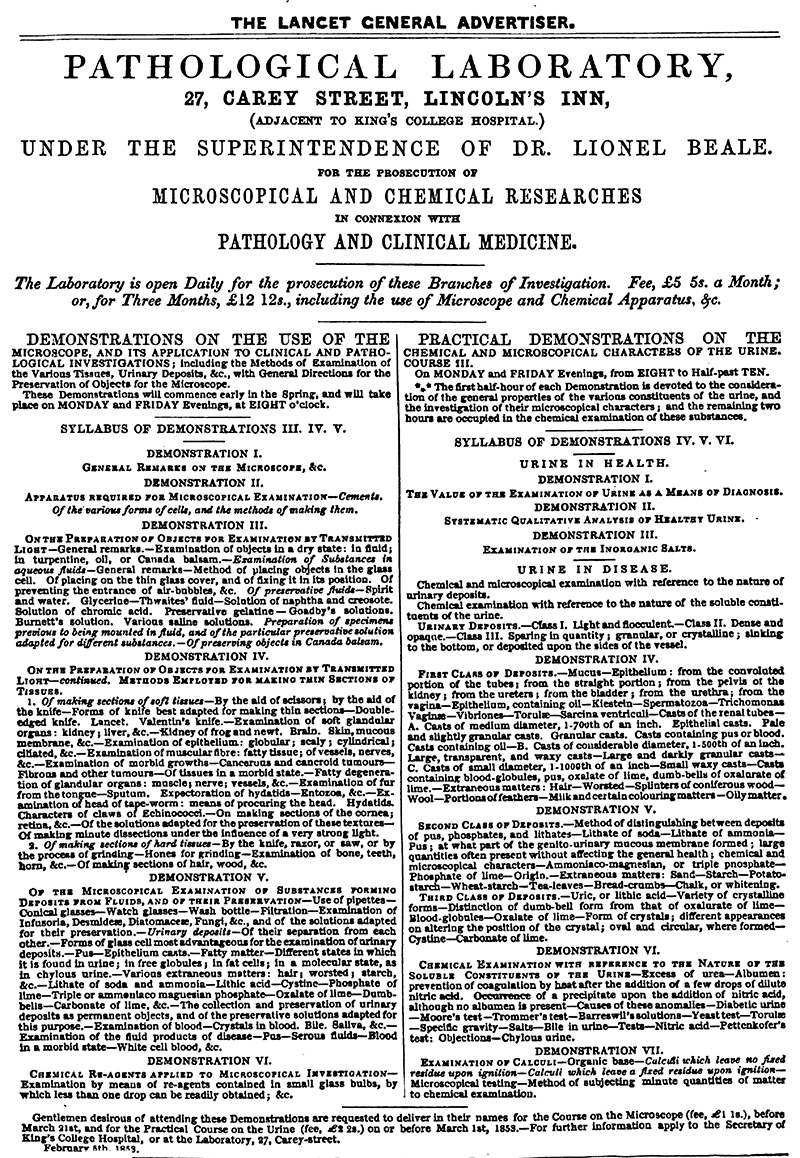
Figure 17.
An 1857 advertisement from Matthews’ neighbor, Lionel S. Beale. In 1874, the Matthews Brothers moved into Beale’s old shop at 27 Carey Street.
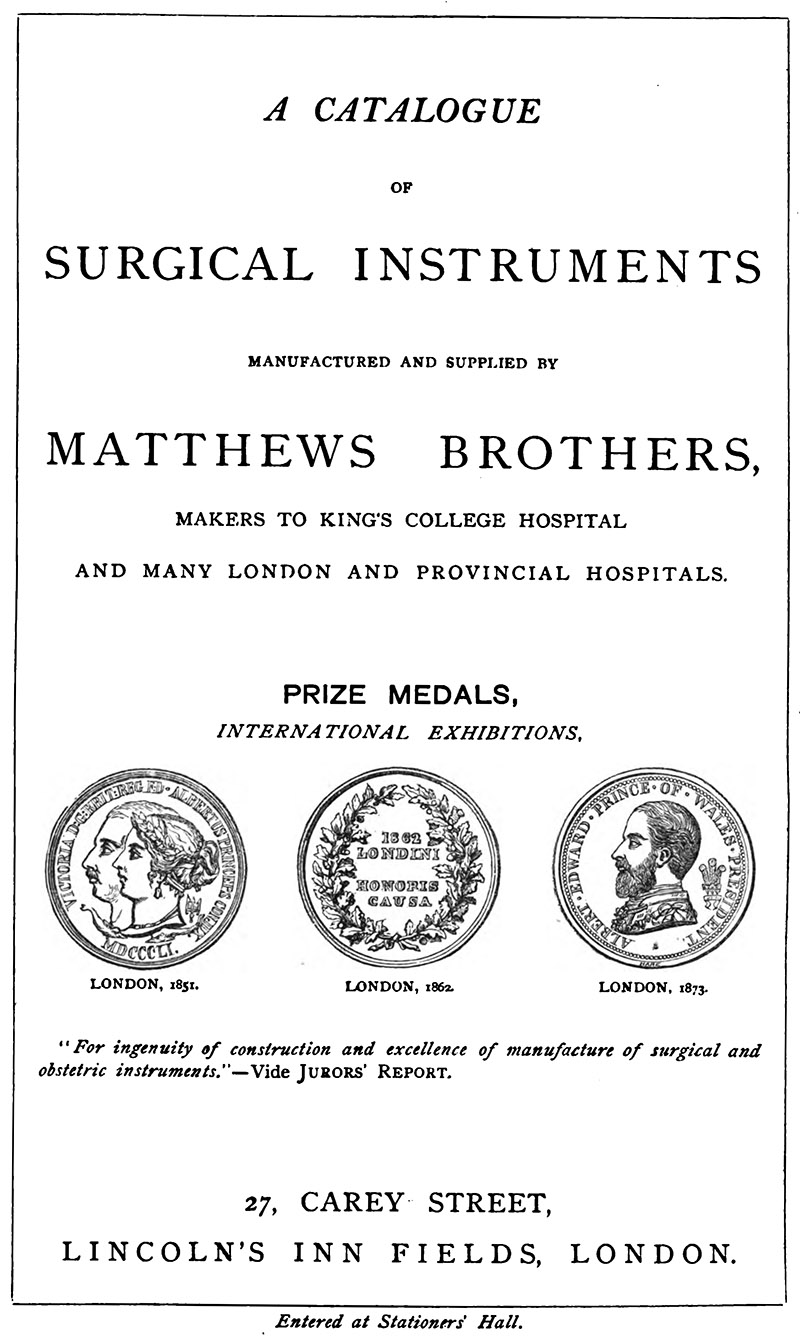
Figure 18.
Cover of the Matthews Brothers’ 1874 catalogue. It includes nearly 4 pages of microscopical equipment.
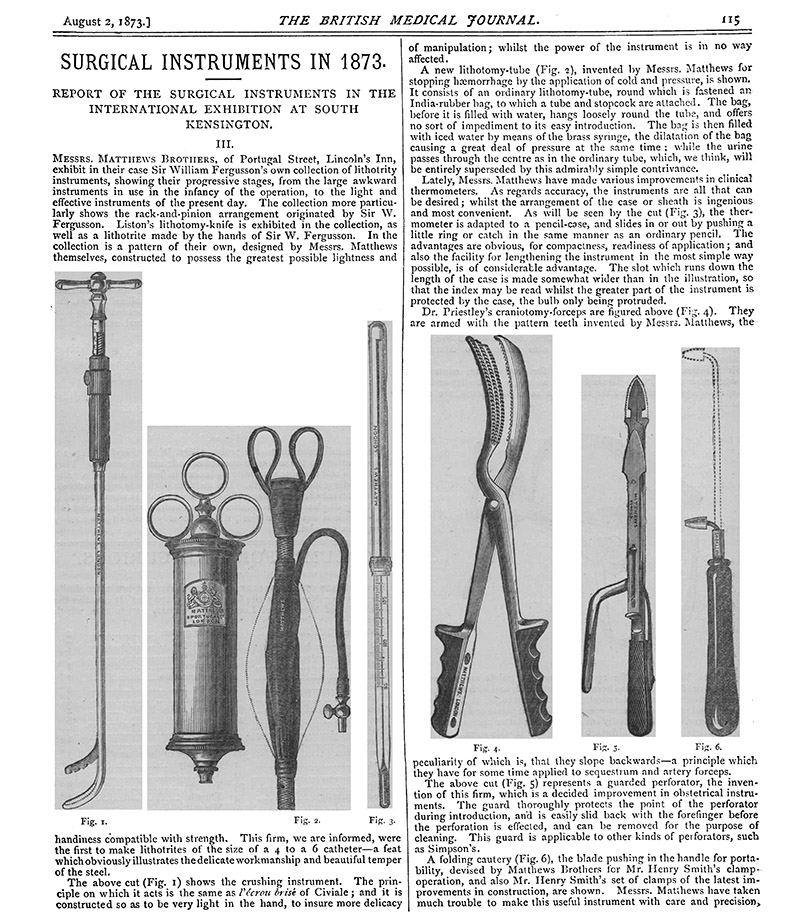
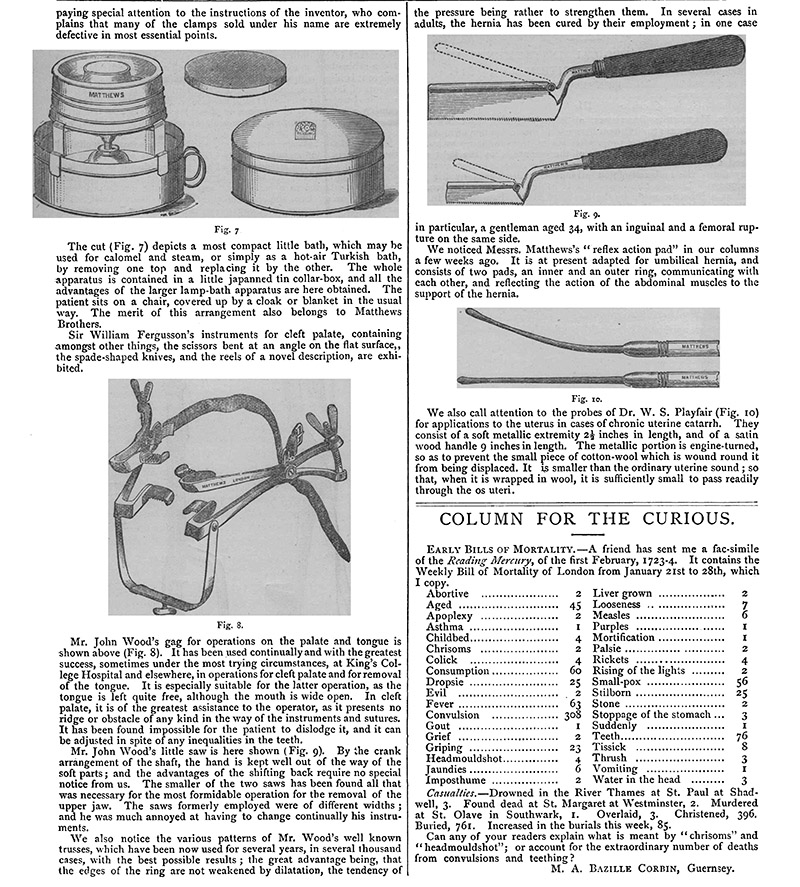
Figure 19.
An 1873 description of Matthews Brothers’ surgical instruments.
Acknowledgements
Many thanks to Joe Zeligs for his generous assistance with this project.
Resources
Apprentice record of William Matthews (1836) accessed through ancestry.com
Baptism record of William Matthews (1815) Parish records of Saint Andrew Holborn, accessed through ancestry.com
Beale, Lionel S. (1857) How to Work With the Microscope, J. Churchill, London, pages 10, 27-28, 39, and 73
Beale, Lionel S. (1861) How to Work With the Microscope, Second edition, J. Churchill, London, frontispiece, pages ix-x, 10, 12, 27, 28, 39, and 73, and plates 13 and 19
Beale, Lionel S. (1863) The Microscope in Medicine, Second edition, J. Churchill, London, page 59
British Medical Journal (1873) Descriptions of medical instruments manufactured by Matthews Brothers, pages 115-116
Diprose, John (1876) Some Accounts of the Parish of Saint Clement Danes, Vol. 2, Diprose, Bateman, and Co., London, pages 7 and 64
England census, birth, marriage, death, and other records, accessed through ancestry.com
Gilbert, Henry (1849) On the Extraction of Teeth, H. Renshaw, London
The Goldsmiths', Jewellers', Silversmiths', Watchmakers', Opticians', and Cutlers’ Directory (1863) “Cutlers (Retail and General) … Matthews Wm., 32 Carey-street, and 8 Portugal-street, W.C.”, W. Hogg and Co., London, page 73
Hogg, Jabez (1861) The Microscope: Its History, Construction, and Applications, Fifth edition, Routledge, Warne, and Routledge, London, pages 68 and 130
The International Exposition of 1862: Official Catalogue of the Industrial Department (1862) page 124
Journal of the Royal Society of Arts (1853) Notice of patent by Rice and Matthews, Vol. 2, page 63
The Lancet (1855) Advertisement from W. Matthews, Vol. 1, April 14 advertiser
The Lancet (1856) Advertisement from W. Matthews, Vol. 1, March 1 advertiser
The Lancet (1857) Advertisement from L. Beale, Vol. 1, February 12 advertiser
Matthews Brothers (1874) A Catalogue of Surgical Instruments Manufactured and Supplied by Matthews Brothers
Medical Times and Gazette (1852) Advertisement from W. Matthews, Vol. 25, March 20 issue, front page
Medical Times and Gazette (1854) “Surgical Instrument Makers … Matthews, Wm., 32, Carey Street, Matthews, Wm., 8, Portugal Street”, New Series, Vol. 9, page 309
Medical Times and Gazette (1857) Advertisement from W. Matthews, Vol. 35, January 10 advertiser
Medical Times and Gazette (1861) Advertisement from W. Matthews, Vol. 2, December 12 advertiser
Medical Times and Gazette (1867) Letters from H. Lawson and W. Matthews, Vol. 2, pages 476, 525, and 607-608
National Archives (1870) Record of registration by Matthews Brothers, 8 Portugal Street, Lincoln's Inn Fields, London, for their “Pocket magneto electric machine”, http://discovery.nationalarchives.gov.uk/details/r/C14037056
Official Catalogue of the Great Exhibition of the Works of Industry of All Nations (1851) page 62
Pigot’s Directory of London (1839) “Cutlers: Matthews Chas. 18 King’s Head ct. Shoe la”, page 105
The Post Office Directory of London (1841) “Matthews Wm. cutler, 11 Portugal st. Lincoln's inn fields”, page 484
The Post Office Directory of London (1856)
Probate of the Will of William Matthews (1868) “12 September. The Will with a Codicil of William Matthews formerly of 8 Portugal-street Lincoln’s-Inn-fields in the County of Middlesex but late of St. Aubin’s Villa Dulwich in the County of Surrey deceased who died 29 June 1868 at St Aubin’s Villa aforesaid was proved at the Principal Registry by the oaths of Ann Matthews of St Aubin’s Villa aforesaid Widow the Relict Charles Samuel Matthews of 25 Southampton-street Strand in the County of Middlesex Esquire and Walter William Matthews of 8 Portugal-street aforesaid Esquire the Sons three of the Executors. Effects under £6000”, accessed through ancestry.com
Snow, John (1848) On narcotism by the inhalation of vapours, London Medical Gazette, vol. 42, pages 840-844